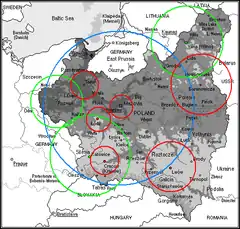Polskie Radio
Polskie Radio Spółka Akcyjna (PR S.A.; English: Polish Radio) is Poland's national public-service radio broadcasting organization owned by the government of Poland.
 Logo used since 2005, updated in 2017 | |
Native name | Polskie Radio S. A. |
|---|---|
| Type | Sole-shareholder company of the State Treasury |
| Industry | Mass media |
| Founded | 18 April 1926 |
| Founder | Zygmunt Chamiec and Tadeusz Sułowski |
| Headquarters | al. Niepodległości 77/85, 00–977 Warsaw , |
Area served | Poland |
Key people | Agnieszka Kamińska (general director) |
| Products | Broadcasting, radio, web portals |
| Services | Radio broadcasting |
| Website | prsa |


History
Polskie Radio was founded on 18 August 1925 and began making regular broadcasts from Warsaw on 18 April 1926.
Czesław Miłosz, recipient of the 1980 Nobel Prize in Literature, worked as a literary programmer at Polish Radio Wilno in 1936.[1]
Before the Second World War, Polish Radio operated one national channel – broadcast from 1931 from one of Europe's most powerful longwave transmitters, situated at Raszyn just outside Warsaw and destroyed in 1939 due to invasion of German Army – and nine regional stations:
- Kraków from 15 February 1927
- Poznań from 24 April 1927
- Katowice from 4 December 1927
- Wilno from 15 January 1928
- Lwów from 15 January 1930
- Łódź from 2 February 1930
- Toruń from 15 January 1935
- Warszawa from 1 March 1937 – known as Warszawa II, the national channel becoming Warszawa I from this date
- Baranowicze from 1 July 1938
A tenth regional station was planned for Łuck, but the outbreak of war meant that it never opened.
After the war, Polskie Radio came under the tutelage of the state public broadcasting body Komitet do Spraw Radiofonii "Polskie Radio" (later "Polskie Radio i Telewizja" – PRT, Polish Radio and Television). This body was dissolved in 1992, Polskie Radio S.A. and Telewizja Polska S.A. becoming politically dependent corporations, each of which was admitted to full active membership of the European Broadcasting Union on 1 January 1993 with the merger of EBU and OIRT.
Channels
National
- Program 1 (Jedynka – One) – information and adult contemporary music – AM-LW (225 kHz)/1333 meters, FM, DAB+ and the internet[2]
- Program 2 (Dwójka – Two) – classical music and cultural – FM, DAB+ and the internet[3]
- Program 3 (Trójka – Three) – rock, alternative, jazz, and eclectic – FM, DAB+ and the internet[4]
- Program 4 (Czwórka – Four) – youth oriented – DAB+ and the internet[5] (also carried as a live video feed in the internet)
- Polskie Radio 24 (PR24) – news (without music) – FM, DAB+ and the internet[6](also carried as a live video feed in the internet)
- Polskie Radio Chopin – Polish classical music – DAB+ and the internet [7]
- Polskie Radio Dzieciom – children programming (daytime), parents magazines (evenings) and Jazz music (nights) – DAB+ and the internet [8]
- Polskie Radio Kierowców – music and information for drivers' – DAB+ and the internet[9]
- Polskie Radio Rytm – pop music – internet only [10]
Regional stations
Polskie Radio also operates 17 regional radio stations (operating on FM, also on DAB+), located in:
- Białystok
- Bydgoszcz (Radio Pomorza i Kujaw)
- Gdańsk
- Katowice (Radio Katowice)
- Kielce (Radio Kielce)
- Koszalin
- Kraków (Radio Kraków)
- Lublin (Radio Lublin)
- Łódź
- Olsztyn
- Opole
- Poznań
- Rzeszów
- Szczecin
- Warszawa (Polskie Radio RDC)
- Wrocław
- Zielona Góra (Radio Zachód)
City stations
Polskie Radio offers city stations in:
- Gorzów Wielkopolski – Radio Gorzów
- Lublin – Radio Freee
- Poznań – MC Radio
- Słupsk – Radio Słupsk
- Szczecin – Radio Szczecin Extra
- Wrocław – Radio RAM
- Zielona Góra – Radio Zielona Góra
All city stations but Radio Szczecin Extra are being broadcast on FM and in Internet, while Radio Szczecin Extra is available only in Internet and via DAB+.
Digital-only
Polskie Radio also offers regional digital-only stations (all operating in Internet and DAB+ only) in:
International
- Radio Poland (known until January 2007 as Radio Polonia) – external broadcasts in Belarusian, English, German, Polish, Russian, and Ukrainian – short wave, medium wave, satellite, DAB+ and the internet[11]
Music charts
Polskie Radio Trójka has been compiling Polish music charts since 1982 – in an era before there were any commercial sales or airplay rankings – making them a significant record of musical popularity in Poland. Chart archives dating from 1982 are available to the public via the station's website.[12]
See also
| Wikimedia Commons has media related to Polskie Radio. |
- Polish Radio External Service
- Informacyjna Agencja Radiowa
- Polish Radio and Television
- Radio stations in interwar Poland
- Narodowa Orkiestra Symfoniczna Polskiego Radia z siedzibą w Katowicach
Other radio stations in Poland:
References
- Haven, Cynthia L. (2006). Czesław Miłosz: Conversations. University Press of Mississippi. pp. xxiv. ISBN 9781578068296.
- PR Program 1
- PR Program 2
- PR Program 3
- PR Program 4
- PR Program 24
- PR Chopin
- PR dla Dzieci
- PR Kierowców
- PR Rytm
- PR DZ (Polish Radio External Service)
- PR Program 3 Music Chart archives (Archiwum Listy Przebojów Programu Trzeciego)